Langebaan – Vredendal – Namaqualand – Springbok – Augrabies Falls – Vryburg – Johannesburg
Slideshow of South Africa West Coast, Wildflowers, Augrabies Falls & Johannesburg
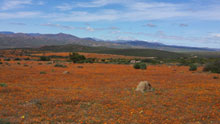
Wildflowers in Namaqua National Park
The wildflower season on the West Coast of South Africa runs from August through to September. This year (2015) has been reported as the best year to see the flowers since 2007 so no time like the present to catch this amazing natural wonder.
We had a rental car and were looking forward to a 6-day road trip to the West Coast, Northern Cape, North West Province, and finally Johannesburg.
West Coast National Park
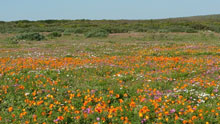
Wildflowers, West Coast National Park
The first stop on our trip to see the wildflowers was Langebaan, about 1.5 hours drive from Cape Town on the West Coast.
The best place in the area to see fields of wildflowers is the West Coast National Park – particularly in the Postberg section.
We entered the Park through the Langebaan Gate, where we paid an entry fee of 60 Rand per person and received a Visitor’s Map of the Park giving details of hiking and mountain bike trails, recommendations on where to stop, and photographs of animals and birds commonly seen in the Park. Once in the Park we made our way into the Postberg section where we saw field after field of white, yellow and orange flowers with the odd display of bright pink. Amazing!
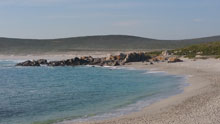
Plankiesbaai
To do it justice, we could have spent the whole day in the Park however we had just a few hours to take in the flowers and the wonderful scenery.
Highlights:
- Fields of flowers in the Postberg Section
- Lookout over Saldanha Bay from the rocks in the Postberg Section
- Plankiesbaai – beautiful, white sandy beach
- Tsaarsbank – dramatic rocks and big surf
- Kraalbaai – scenic beach with long jetty, a good place for swimming.
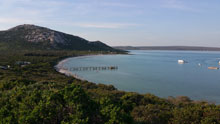
Kraalbaai
There are plenty of wonderful places for picnics or BBQs in the Park. We would also recommend a stop at the Geelbek Restaurant & Visitors Centre plus the Bird Hide nearby to see the flamingos.
If you fancy staying in the Park overnight, there are a number of accommodation options. For details see – www.sanparks.org/parks/west_coast/all.php
Langebaan/Mykonos – Accommodation & Restaurants
We stayed at Paradise Beach, a private estate near Club Mykonos. There are holiday rentals in the Paradise Beach estate, in Club Mykonos and in Langebaan nearby.
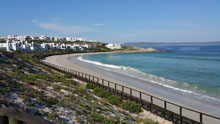
Paradise Beach
Accommodation:
- Paradise Beach
- Club Mykonos
- Langebaan Apartments Booking.com
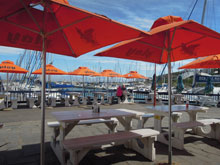
Dockside Cafe & Lounge
Restaurants:
- For a real West Coast experience visit Alegria at nearby St Helena Bay. This rustic restaurant is right on the water. We visited for dinner and a highlight was the live music and the views. There were three choices for main (chicken, ribs or chicken livers in peri peri sauce) plus either Malva pudding or Lemon Meringue for dessert.
- Back in Club Mykonos we loved Marcs Beach Bar – right on the beach. A relaxed atmosphere and the calamari is delicious.
- Next door is Lekka by Die See – also recommended.
- Dockside Café & Lounge – a great place for breakfast overlooking the harbour.
The West Coast
Leaving Langebaan, we travelled along the West Coast headed for Vredendal.
The first place of interest was Veldrift – as you cross the bridge into the town, look out for the flamingos.
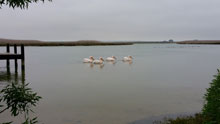
Pelicans, Bokkom Lane
Just over the bridge we turned right and followed the road around for about one kilometre, turning right into Bokkom Lane. This was a surprise – the lane is right on Bird River and it’s a beautiful spot to see pelicans and other birdlife in a tranquil setting. There are a number of little rustic cafes along the lane and it seems to be a popular place to stop for coffee.
We then went on to Laaiplek (about 1.6kms) where we followed the signs to the harbour. The homes are built along a canal and it is a pleasant place for a walk.
From there it was about 34kms to Elands Bay. It is a good road however there is not much in the way of scenery. Elands Bay is a tiny settlement where there are a couple of places for a meal – the Elands Bay Hotel has an old-fashioned dining room (serving breakfast lunch and dinner) that overlooks the sea, and across the carpark is Wit Mossel Pot restaurant.
With just a quick stop in Elands Bay we continued on toward Lambert’s Bay. This small fishing town was very quiet on a Sunday.
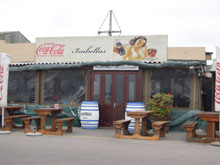
Isabellas Restaurant
Of interest there:
- Bird Island – one of only six sites in the world where the blue-eyed Cape gannet breeds. Entry tickets are available from the little hut at the harbour. The hide and information centre is accessible by walking about 100m along a breakwater out to the island. (www.capenature.co.za/reserves/bird-island-nature-reserve)
- Isabellas Restaurant – serving traditional West Coast dishes, located at the harbour overlooking Bird Island (isabellasrestaurant.co.za)
- Muisbosskerm – a rustic, West Coast restaurant, about 5kms south of Lambert’s Bay, serving typical seafood dishes (muisbosskerm.co.za).
Vredendal
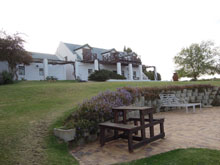
Melkboomsdrift Lodge
From Lambert’s Bay we drove to Vredendal, arriving about 5pm. As it was still early, we took the road to Lutzville hoping to see wildflowers but unfortunately there were very few.
We checked into our accommodation – Melkboomsdrift Guest Lodge, which was on the Vredendal-Lutzville road (R363) about 20 minute’s drive from Vredendal and 10 minutes from Lutzville.
This charming Lodge is an historic farmhouse on a working wine farm with lovely views over the Olifants River Valley. The homestead and outbuildings have been painstakingly restored and have been declared National Monuments. We stayed in Die Skooltjie – the small schoolhouse – lovely accommodation. Dinner and breakfast were served in a rustic and charming building across the lawn from our room – also with views over the valley.
Vredendal to Springbok
We woke to cloud and rain on the day we were to drive to Springbok. This was disappointing as the wildflowers only open when the sun shines.
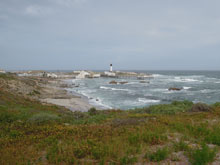
Doringbaai
Realising it wouldn’t be a good day to view wildflowers; we took a 30-minute drive out to Doringbaai, a tiny village on the coast. We drove down to the little harbour to try and visit Fryer’s Cove Wine Cellar (located on the jetty) however the gate was locked and all appeared closed. Fryer’s Cove is unique in that it is one of the closest cellars and vineyards to the sea. We advise phoning before you visit to check on opening times (www.fryerscove.co.za/en).
From there we returned along the same road towards Strandfontein, a few minutes down the road. On the way we saw a very long train – around 2km long! We had heard of these amazing trains that transport iron ore to the coast for export. Seeing was believing.
Strandfontein is clearly a holiday destination in summer with most of the town consisting of holiday houses. It has a relatively long, sandy beach, which in summertime would be very inviting however we experienced wind and rain so the atmosphere was quite different!
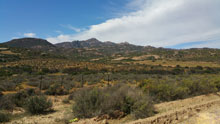
N7 to Springbok
We returned to Vredendal through a patchwork of vineyards, and onto Vanrhynsdorp on the R27. After a quick stop at the Old Jail nursery, we took the N7 towards Garies, Namaqua National Park and Springbok.
It was 140kms to Garies were we made a lunch and petrol stop. We were now in the Northern Cape.
Our lunch stop was at the Garies Tourist Stall & Information Centre where we were told the best spots to see the wildflowers between Garies and Springbok:
(i) Skilpad in Namaqua National Park, and
(ii) 15km along the road to Grootvlei off the N7 at Kamieskroon.
However, due to the rainy weather we continued onto Springbok without stopping, and hoped to see the flowers the next day if the weather improved.
Springbok
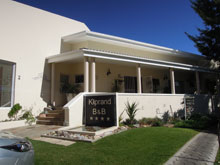
Kliprand Guesthouse
Springbok is quite a busy town as it is the main centre in the Namaqua region and an ideal stopover between Cape Town and Namibia. It is also busy during Spring when people visit to see the wildflowers.
Around Springbok, the best places to see the wildflowers are on the road to Nababeep and Concordia. Despite the weather, we saw fields of orange and yellow flowers at Nababeep, and on the road to Concordia, we saw purple, yellow and orange fields – however they would have been more pronounced in sunny conditions.
Returning to Springbok we checked into the Kliprand Guesthouse. We had a friendly welcome and a comfortable room.
The Tauren Steak Ranch (www.springbokinfo.co.za/Tauren.htm) was the recommended dinner venue and on arrival at around 6.30pm it was fully booked until 8pm! Fortunately we were able to have our dinner at the bar (the bad news for us was that smoking was allowed at the bar!). Despite that, we can highly recommend the food and service.
Wildflowers at Skilpad, Namaqua National Park
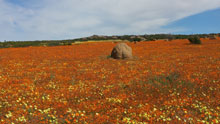
Wildflowers, Namaqualand
The following day was clear and sunny, and on the advice of our hosts at Kliprand Guesthouse and the Tourist Information Office, we headed back to Skilpad to see the flowers in the Namaqua National Park.
We took the N7 from Springbok back to Kamieskroon (about 70kms or a 50 minute drive), where we turned left, then left again at the T-junction, passed the hotel, then followed the road around to an underpass (under the N7 road) where we finally saw a sign – “Namaqua 17km” (there is no sign on the N7 to the Namaqua National Park so look for the sign to Kamieskroon). The road was quite suitable for a 2WD however for other roads in the Park beyond the wildflowers, a 4WD is needed.
Arriving at Skilpad, we could see the beginnings of the flowers. We stopped at the entry gate where we paid 64 Rand each (non South African citizen rate), were given a map/brochure and proceeded to a second gate – that was where the real beauty was. A circular drive took us around the fields of wildflowers. They were like nothing we had ever seen before – absolutely beautiful.
We would recommend spending a couple hours around Skilpad inside the Park. There is a place for lunch – Skilpad Plaaskombuis Country Kitchen, an Information Office, and walking trails through the flowers.
Springbok to Augrabies Falls National Park
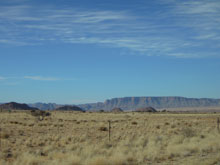
N14 Springbok to Augrabies
We arrived back in Springbok around 2.30pm, had a late lunch at Wimpy, filled the car with petrol and took the N14 in the direction of Upington to Augrabies Falls. It was a long straight road through big open country – beautiful semi-arid scenery.
We passed a couple of mines where zinc, copper, lead and silver are extracted, with only a small town called Pofadder along the way. At Kakamas (about 95kms before Upington) we turned off the N14, onto the R359 in the direction of Augrabies and it was 40kms to Augrabies Falls National Park.
The R359 took us through vineyards, concrete slabs used to dry fruit, and passed The Raisin Company. On reaching the Augrabies Falls National Park Gate, the rest camp was another 3kms.
We booked into Chalet 25 at Augrabies Falls Rest Camp – very well located a couple of minutes walk to Reception, the shop and the restaurant.
Before sunset, we walked down to see the Falls. There are timber walkways built to make the walk to the Falls and along the gorge much easier than climbing over rocks. We were impressed with the flow of water although photos near Reception show the Falls in flood – a really impressive site!
What we loved about the Falls was that the water is channelled through a narrow space between the rocks which turns the flow of the river into a powerful waterfall, dropping around 90m and then flowing through a massive ravine.
Our accommodation was a very comfortable, spacious, self-contained chalet with bathroom. We were unable to receive WIFI (were told that there is normally WIFI however a technician was unable to fix a problem that day). We had not carried food with us so had dinner in the Quiver Tree Restaurant. It had a very nice atmosphere, lovely waitress and delicious food. Probably the best meal we have had at a SAN Park restaurant.
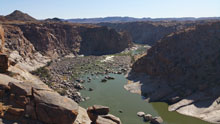
View at Ararat
Next morning we took another walk to the Falls. There were lots of dussies basking on the rocks in the morning sun. After a delicious Farmhouse Breakfast at The Quiver Restaurant, we drove into the game reserve, visiting Moon Rock, Ararat and Oranjekom. The latter two lookout points have spectacular views of the gorge and it’s well worth the drive.
Leaving Augrabies Falls around 10.30am we had a long drive ahead of us – we hoped to get to Molaka National Park near Kimberley by the evening. We thought Molaka would be an interesting stopover on the way to Johannesburg.
We took the R359 to Kahamas (where we are able to get wifi and check our emails) then the N14 to Upington. Upington is a major centre and the gateway to the Kalahari. We filled up with petrol there, had a quick salad and got directions for Kimberley.
We took the N14 towards Olifantshoek (GPS was telling us to go that way too). However, just before Olifantshoek, GPS indicated we should take the R385 – it was a gravel road and given the distance we still had to travel and the condition of the road, we realised we were not going to make it to the Molaka NP Gate before it closed at 5.30pm. We also realised that we should have taken the N10 and N8 from Upington to Kimberley!
Vryburg
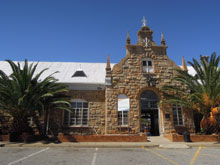
Klerksdorp Railway Station
Time for a quick change of plan! We decided to head to Vryburg and spend the night there. Phoning ahead, we found that all the guesthouses we tried had no vacancies – there was a car rally in Vryburg on the weekend. We finally found a room at 41 on Market in Vryburg. This is a very comfortable hotel on the main street of Vryburg and we received a very friendly welcome. For dinner that night we had a delicious steak and ribs at the local Spur Restaurant – highly recommended.
The next morning we got away around 8.30am, after a good breakfast at 41 on Market. We were headed for Johannesburg via Klerksdorp, Orkney and Vaal Reefs. These are mining towns and, with the closing of many of the gold mines in the area, have seen better days.
Johannesburg
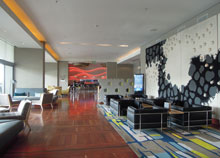
Radisson Blu Guatrain Hotel
We arrived in Johannesburg around 5.30pm during peak hour traffic. Driving to the Raddison Blu Gautrain Hotel in Sandton with the GPS was easy enough – just slow.
When we reached the hotel there was secure parking underneath the building. At Reception the room type we had requested was not available however we were kindly upgraded to a Business Class room! This lovely room – 402 – included breakfast, car-parking and a daily newspaper.
That evening we enjoyed a delicious dinner at the hotel restaurant on the 3rd floor, after which we saw the Concierge to organise a quick tour of Johannesburg and Soweto the following day.
Next morning at 9am, after a delicious buffet breakfast in the hotel, we met our driver Otto in the lobby and were on our way.
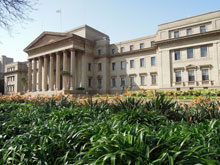
Wits University, Johannesburg
Otto is a charming man who drove us through downtown Johannesburg with a running commentary on each area. We by-passed Hillbrow (a no go area), passed Constitution Hill, Braamfontein where we stopped to see Wits University, the Carlton Centre where we took the a lift to level 60 for great views of the city, and then to the Apartheid Museum. We spent just over one hour there however if you were to read everything you would probably take three hours to see it all.
Next stop was Vilakazi Street, Orlando West, Soweto, where the first stop was to visit the Mandela House (www.mandelahouse.co.za). We had a very informative guide take us through and then we were free to wander and take photographs. This was the house Mandela lived in with his first wife and their children, then with Winnie before he went to prison, and again for a short time when he was released from prison in 1990. In 1999 the house was declared a National Heritage Site. It underwent major renovation and restoration in 2008-9 and was re-opened in March 2009. It is well worth a visit.
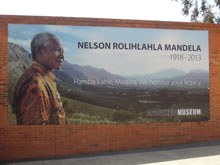
Apartheid Museum
Vilakazi Street is unique in that two Nobel Prize winners lived there – Nelson Mandela and Desmond Tutu.
After visiting the Mandela House we walked along Vilakazi Street for lunch at Sakhumzi Restaurant. There were lots of tourists there, a good selection of food and sweets, and African dancing and singing.
Vilakazi Street is now a popular place with tourists – it is lively and vibrant – with African wares for sale; and a number of bars and restaurants.
From there we drove passed Orlando West High School, one of the most famous schools in Soweto for its student protests in 1976. Around the corner in Moema Street is the Hector Pieterson Memorial and Museum. This was another very moving experience with images and information on the apartheid years, focusing on student protests.
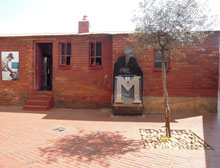
Mandela House, Vilakazi St, Soweto
Otto had us back to our hotel at about 4pm. It had been an emotional day and was just a glimpse of life in Johannesburg and the apartheid years. The tour was certainly worth doing.
For anyone with a bit more time, there is also a Hop On Hop Off bus tour of Johannesburg with an add-on tour to Soweto. Tickets can be purchased for either one day or two days. We noticed at the Carlton Centre that a guide escorted passengers to Level 60 and gave a commentary of the city.
In the evening we had dinner at Moyo Restaurant at Melrose Arch. We can recommend this restaurant for a taste of traditional South African food, and for the live music. Melrose Arch is a vibrant, attractive shopping precinct with lovely outdoor eating areas.
The next day, our flight back to Australia was due to depart at 7pm. The hotel very kindly extended us a late check out until 3pm.
After a late breakfast, we walked to Sandton City shopping mall (just 5 minutes away) however the whole area was a construction zone. Nelson Mandela Square was mostly boarded up and inside the mall itself there were renovations underway. We read that these were due for completion by the end of the year (2015). It was dusty and noisy so we returned to the hotel.
There was also construction underway next door to the Radisson Blu Guatrain however this doesn’t appear to impact on the hotel.
If you are in South Africa during Spring, and have the opportunity to see the wildflowers, it is well worth doing so. And Johannesburg is an interesting stopover with much to see.
AccommodationGuru
September 2015
